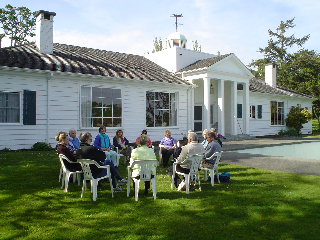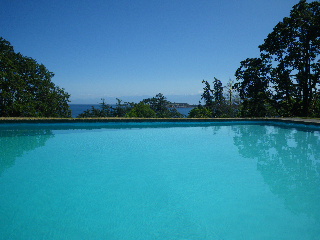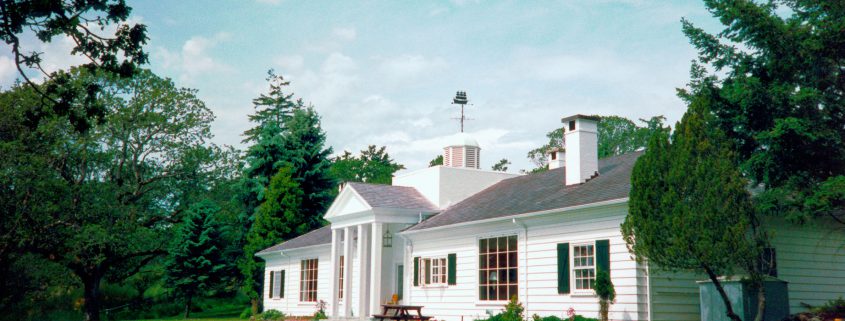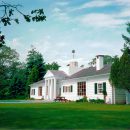Swanwick Star Issue No. 2 (2009)
Swanwick Centre Events in 2009
Krishnamurti (K) DVDs were shown, monthly on Sunday afternoons, from March 15 until November 8. The videos included short introductions to K’s life and teachings followed be a selection from “The Real Revolution” series filmed in 1966, the first time K had allowed his talks to be recorded on film. Each video was followed by a dialogue of about 1 ½ to 2 hours. The sessions were facilitated by Ralph Tiller and David Bruneau. Participants were a mix of those who have been interested in K for many years and complete newcomers, and generally it was felt that the afternoons were interesting and beneficial. When the weather allowed we were able to sit outdoors and enjoy the inspiring setting: the trees, birds, ocean, and snow-capped mountains in the distance. It is hard to imagine an environment more beautiful and conducive to deep reflection.
Three K weekend retreats were held over the summer (July to September), again comprised of a combination of videos and dialogues facilitated by David and Ralph; about ten people were present for each. The first retreat featured discussions between K and Alan Anderson; the second between K, David Bohm, and the psychiatrist David Shainberg. This second retreat was attended by six persons active in K events in Vancouver and provided a great opportunity to connect and exchange experiences.
The third retreat was to have been facilitated by Mark Lee from Ojai, California, but Mark was unable to attend for health reasons; so Ralph and David were asked to step in as organizers and hosts. Canadians were outnumbered by Americans on this international weekend. Material from the Alan Anderson series was again used, with some changes from the first retreat. The participants had almost all been studying K for some time, which set the tone for a perhaps deeper investigation than previously. The retreat was valued highly by all involved and, again, the beautiful setting inspired self-exploration.
Retreats presenting other, contemporary teachings aligned with those of K were also included this year. In May and October two retreats were hosted by Ralph and Madelaine Tiller based on the teaching of Eckhart Tolle, author of “The Power of Now”. They included two of his retreats on DVD, namely “Freedom from the World” and “The Art of Presence”, guided meditations on CD by his partner Kim Eng and guided qigong movements. Eckhart’s insights and gentle humour were much appreciated by participants. The May retreat was attended by 18 residential and day participants, while the October retreat had much fewer participants, due in part to cancellations for health reasons, as well as public interest in attending the Vancouver Peace Conference with the Dalai Lama and Eckhart Tolle which was taking place at about the same time.
In June a retreat based on DVDs of Adyashanti, a teacher from California, was also hosted by Ralph and Madelaine. It was attended by altogether 10 participants. The DVDs covered his most recent ‘satsangs’, a combination of talk and dialogue about the nature of truth, meditative self-inquiry and the journey of awakening. They were complemented with guided meditations by Adyashanti as well as an illuminating DVD with him on the journey after awakening. Participants enjoyed his engaging approach and the interactive format of the sessions.
On the Labour Day weekend in September a retreat was held to explore the perspectives of the Jamaican advaita teacher Mooji. DVDs recorded at a silent retreat in Tiruvannamalai, India, in December, 2008, were the focus material along with a couple of guided meditations with Mooji on CD. Twelve people attended the weekend. The highlight of the retreat was a live skype session with Mooji, who was in New York at the time, in which participants could interact directly with him. This was greatly appreciated by all. The weekend was permeated by a sense of harmony and joy in coming together around the self-inquiry pointed to by Mooji.
To allow for a deeper immersion, parts of these retreats were held in silence, which allowed for deeper immersion in the teachings and was widely appreciated, leaving ample time for nature walks, silent contemplation, and silent sitting.
The feedback from retreat participants indicates a demand for these types of gatherings and an interest in continuing them. The dialogue ‘process’ undergoes continuous refinement as it is engaged in and proves to be an environment of learning and discovery for those who give it their passionate attention. It is an environment where understanding and insight can arise and be shared with others as a part of an ongoing meditation on life.




